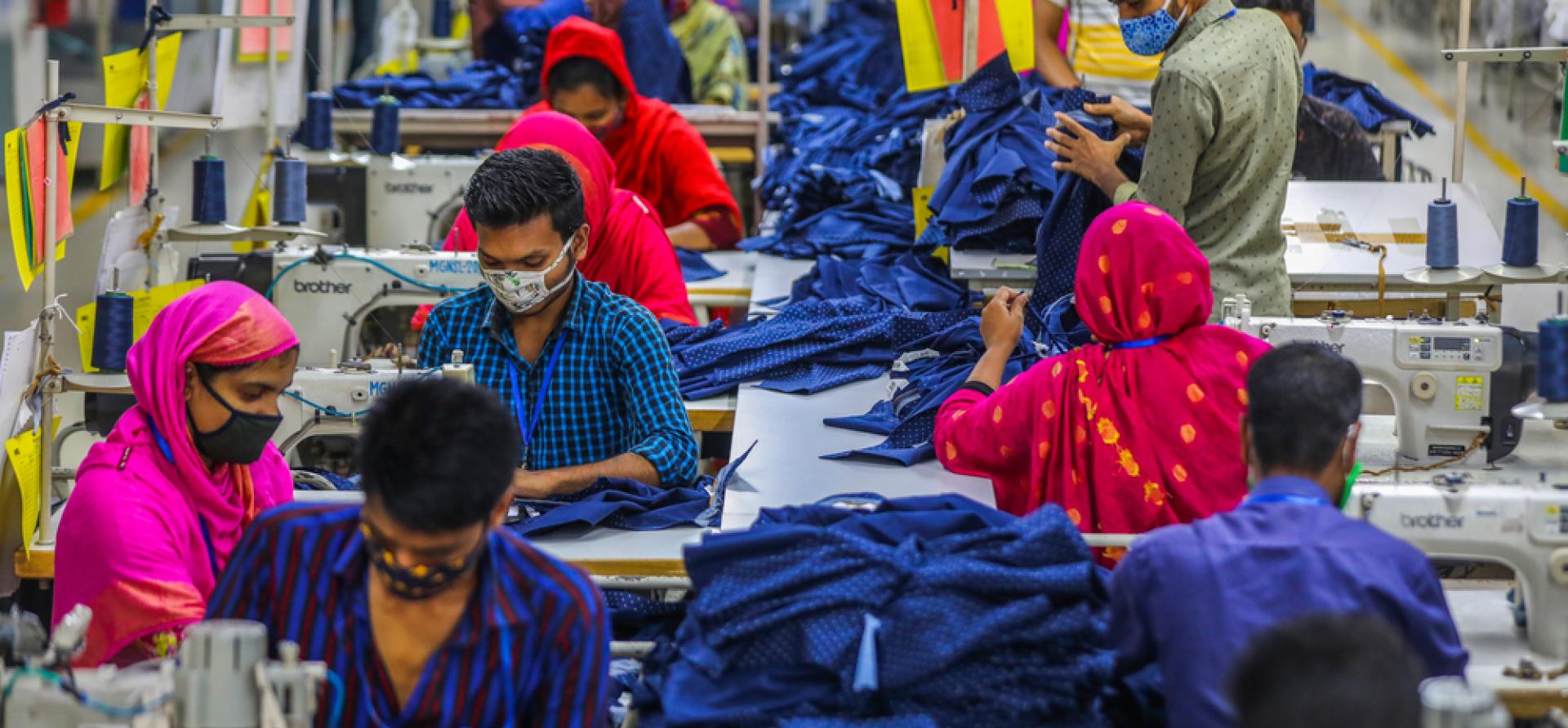Moving towards a green garment sector in Bangladesh

Key Findings
The readymade garments (RMG) sector, which makes up more than 80% of the country’s export earnings, has pledged to cut down 30% of its greenhouse gas (GHG) emissions by 2030. However, despite deploying a combination of energy efficiency and conservation measures, the sector might still fall significantly short of the target.
While buying carbon credits from voluntary carbon markets is an option to offset emissions, RMG factories will not find this viable. They would prefer buying renewable energy generated by independent power producers, riding on corporate power purchase agreements (PPAs). With long-term PPAs, the RMG sector can decarbonise its production process at an accelerated rate.
A policy landscape that offers a clear pathway to procure competitive solar energy is a necessary precondition as the export-oriented garment industry of Bangladesh competes in the international market. Besides, support from the international buyer will help create a green and just energy transition in Bangladesh’s RMG sector.
American author Neale Donald Walsch said, “The era of the Single Savior is over. What is needed now is joint action, combined effort, collective co-creation.” Walsch’s quote, taken in the context of Bangladesh’s readymade garments (RMG) sector, reflects the elements that are the need of the hour for a green energy transition.
The RMG sector, which makes up more than 80% of the country’s export earnings, needs to spearhead ambitious greening efforts amid the growing sustainability measures pursued by international garment buyers. Together with international buyers and support from the government, the RMG sector needs to create a strong strategy for an effective and just transition to green energy.
The sector has already pledged to cut down 30% of its greenhouse gas (GHG) emissions by 2030. However, this is an ambitious goal and may require meeting incremental mitigation targets set by buyers in the foreseeable future.
The imperative for incremental efforts
Although rooftop solar plants appear to be low-hanging fruit to reduce fossil fuel-based electricity consumption, discussions with stakeholders reveal that capping rooftop solar energy installation to 70% of the sanctioned load may limit the use of clean energy by many industries to 5%. This is because industries, which also include drying, washing and other units, have significant energy consumption. Many old industries cannot accommodate rooftop solar systems of 70% of the sanctioned load as their roofs lack weight-bearing capacity.
Some factories have already been pursuing energy efficiency measures as part of their continuous improvement process. A combination of energy efficiency and conservation measures and rooftop solar intervention might still fall significantly short of the 30% GHG mitigation goal. The international buyer, for example, multinational clothing company H&M, has a more ambitious GHG mitigation goal to reach by 2030. Notably, manufacturing units in host countries produce a significant part of the overall GHG emissions of an international buyer. This will posit the need for additional green interventions in the RMG sector.
Corporate PPAs may help
While buying carbon credits from voluntary carbon markets is an option to offset part of the emissions, RMG factories will not find this viable. Instead, they will prefer buying renewable energy generated by independent power producers (IPPs), riding on corporate power purchase agreements (PPAs). Seminars broach similar discussions for several reasons. For instance, IPPs dominate Bangladesh’s renewable energy sector, and this trend will continue in the foreseeable future. The contribution of renewable energy to the national grid is also limited, and the energy consumption need of the RMG industry is unique in relation to its emission reduction goal.
With long-term corporate PPAs, the RMG sector can decarbonise its production process at an accelerated rate while paving the way for increasing the share of renewable energy to the national grid and contributing to the country’s Nationally Determined Contributions under the Paris Agreement.
The private sector may build on the experience of renewable energy IPP projects. However, distribution utilities may not appreciate corporate PPAs owing to the concern over revenue loss from electricity sales. Distribution utilities can still generate revenue by charging a transmission cost.
Industries must confirm that they have used the available rooftop space for solar systems before purchasing additional electricity from IPPs. Land-starved Bangladesh does not have the luxury of relying solely on ground-mounted solar systems.
While more stakeholder discussions are expected on the demand for corporate PPAs in the coming days, such agreements are complex, with potential grounds for future disputes. Therefore, for the sustainability of corporate PPA as an instrument, the government’s regulatory guidelines shall consider future challenges along with mediation.
Globally, contracted corporate PPAs were more than 10% of the total renewable energy capacity addition in 2021. Corporate PPAs have also created significant interest among Indian consumers in light of the climate goals of business entities. Project developers in India expect corporate PPA volume to grow by 10 gigawatts (GW) annually soon. Bangladesh can take lessons from India’s experience regarding the challenges and the way forward.
No impetus for green energy
As of 8 March 2023, Bangladesh had 192 green RMG factories, certified by the United States Green Building Council (USGBC) under the Leadership in Energy and Environment Design (LEED). The Bangladesh Garment Manufacturers and Exporters Association (BGMEA), the RMG sector’s apex body, received the USGBC leadership award in 2021 for making strides towards green energy in the sector.
However, garment exporters feel they do not get any impetus for the additional cost they incur on their greening efforts. The absence of incentives may hinder them from furthering their green ambitions.
Greening efforts, which come at a cost, should not adversely affect around 5 million people, employed in the sector.
Since international buyers and local garment manufacturers have a common vision of reducing emissions, having a premium price for products could provide relief to the factory management. However, local garment manufacturers should do this considering the price competitiveness of their products in the international market.
Factories need other support as well. They may be informed of recent technology trends and told about the different approaches they can adopt for a smooth transition to green energy. International buyers may enhance capacity development programmes for factories. The recently signed Memorandum of Understanding (MOU) between BGMEA and H&M for cooperation on GHG mitigation is a step in the right direction.
A policy landscape that offers a clear pathway to procure competitive solar energy is a necessary pre-condition as the export-oriented garment industry of Bangladesh competes in the international market, which is now more aware of climate change. Besides this, support from the international buyer will help create a green and just energy transition in Bangladesh’s RMG sector.
This article was first published in The Apparel Story.















